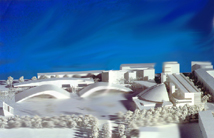|
Welcome
Safety
Products
Experiments
Events
Photographs
Galilée
Highscool
Contact
Bibliography
|
| |
|
| |
- Set up a distillation assembly / carry out an assembly with
the backward flow.
- In a 250 mL dicol, pour 20 ml of pure glacial ethanol
acid, 15 mL of isoamyl
alcohol (or 3 - methylbutan - 1- ol), then 1 mL of
concentrated sulfuric
acid.
- Add a few grains of pumice, then heat the whole with the backward
flow for 30 minutes.
- Cool the dicol, then pour its content into a 250 mL separatory
funnel.
- Add 25 mL of sodium
bicarbonate solution.(CAUTION
: A strong bubbling occurs. As soon as the gas evolution
has almost ceased, seal the funnel, then shake / stir it with
its valve open to eliminate the gas which is produced, and let
it decant.)
- Throw away the aqueous phase into the sink, and pour the organic
phase into a dry Erlenmeyer flak.
- Dry the organic phase with some anhydrous magnesium
sulfate. Filtrate it on a paper folded filter, then
collect the fitrate into a 100 mL ground-in monocol fat flask
/ a ground-in boiling flask.
- Distil the dry organic phase, and collect the portion over 137°
temperature into a ground-in 50 mL Erlenmeyer flask (isoamyl
acetate or ethanoate
of 3 - methylbutyl).
CAUTION : It is important to work
under a hood and to wear gloves and safety goggles
while manipulating glacial ethanol
acid and concentrated sulfuric
acid.
|
|
Boiling point ( p = 1 bar)
|
Density
|
Solubility in water
|
|
Isoamyl alcohol
|
131
|
0,81
|
slightly soluble
|
|
Ethanol
acid
|
117
|
1,05
|
highly soluble
|
|
Isoamyl acetate
|
142
|
0,87
|
slightly soluble
|
|
| |
Ilustrations |
|
© minc.f.
|
|



